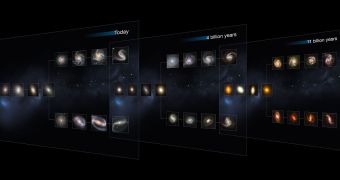A massive survey of the early universe made using the Hubble Space Telescope provided some surprise discoveries, though the surprise was that there wasn't anything that surprising to be found, i.e. things back then looked pretty much like they do now.
Astronomers wanted to know if the current variety of galaxies and their current classification held true in the early universe, some 11 billion years ago.
For this, they devised the biggest study Hubble has ever undertaken. Looking at a large number of early galaxies, just a few billion years after the universe was created 13.82 billion years ago, astronomers observed the same type of galaxies we're familiar with.
The Hubble Sequence, after the same astronomer that gave the telescope its name, divides galaxies into two groups.
Spiral galaxies, which are usually young and active, since they still have plenty of gas to burn and create new stars, and elliptical galaxies, which are largely inactive. Finally, there are also lenticular galaxies which are more of a transition phase between the other two.
It turns out that the galaxies of 11 billion years ago were largely the same as now as astronomers found the same distribution of shapes. This is true for relatively smaller galaxies, though; larger ones like the Milky Way were rarer back then since they had not had enough time to form and are still rare today.
The study does put some pressure on some galaxy formation theories, as they don't explain how all of these types of galaxies could have formed this early.
"This is the only comprehensive study to date of the visual appearance of the large, massive galaxies that existed so far back in time," co-author of the study Arjen van der Wel of the Max Planck Institute for Astronomy in Heidelberg, Germany said.
"The galaxies look remarkably mature, which is not predicted by galaxy formation models to be the case that early on in the history of the universe," he added.

 14 DAY TRIAL //
14 DAY TRIAL //